14.1.4: Silicate Class - Ring Silicates
- Page ID
- 18648
Tourmaline
(Na,Ca)(Fe,Mg,Al,Li)3Al6(BO3)3Si6O18(OH)4
Ring silicates have structures in which all silicon tetrahedra are in hexagonal (6-membered) rings. Using this definition, tourmaline is the only common example. The very rare minerals dioptase, CuSiO2(OH)2, and benitoite, BaTiSi3O9, are also ring silicates. Mineralogists sometimes group beryl and cordierite with tourmaline because the two minerals, like tourmaline, contain hexagonal rings of tetrahedra. But, in beryl and cordierite, tetrahedral rings are connected by additional silica tetrahedra that are not in rings.
For more general information about the ring silicates, see Section 6.4.6 in Chapter 6.
Tourmaline (Na,Ca)(Fe,Mg,Al,Li)3Al6(BO3)3Si6O18(OH)4
Origin of Name
From the Sinhalese word toramalli, meaning “brown,” the color of some tourmaline gemstones from Ceylon.
Hand Specimen Identification
Common occurrence in pegmatites, prismatic crystal habit, pseudohexagonal cross section, vitreous luster, hardness, and conchoidal fracture are characteristic and typically identify tourmaline. But, tourmaline comes in many different colors. Black tourmaline may be confused with hornblende; small crystals may superficially resemble staurolite.
Figure 14.146 is a photo of common black tourmaline, a variety called schorl, in a pegmatite. The crystal in the center of the sample gives a hint of tourmaline‘s pseudohexagonal symmetry. Figure 14.147 also shows schorl. The pseudosymmetry is present in this specimen too, but is hard to see because of the angle of view. Figure 14.148 is a photo of rubellite, a red variety of tourmaline; and Figure 14.149 is a photo of elbaite, a green variety.
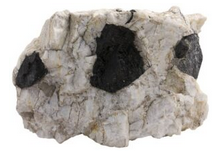
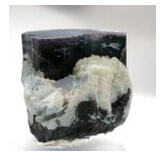

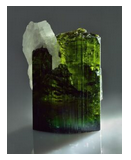
Physical Properties
| hardness | 7 to 7.5 |
| specific gravity | 2.9 |
| cleavage/fracture | poor {101}, poor {110}/ subconchoidal |
| luster/transparency | vitreous, sometimes resinous/translucent |
| color | variable black, blue, green, red, colorless; often zoned |
| streak | white |
Properties in Thin Section
In thin section, tourmaline’s color and pleochroism are strong and variable: black, brown, green, blue, yellow, red, or pink. The color usually masks the birefringence. Pseudohexagonal or triangular cross sections are typical. Tourmaline is uniaxial (-), typically ω = 1.645 to 1.670, ε = 1.625 to 1.640, δ = 0.020 to 0.030.
Crystallography
Tourmaline forms trigonal crystals. Its unit cell dimensions are a = 15.84 to 1.603, c = 7.10 to 0.722, Z = 3; space group R3m; point group 3m.
Habit
Elongate trigonal prisms, sometimes appearing hexagonal, with vertical striations are common. Cross sections appear hexagonal or ditrigonal, with or without some rounded angles between faces. Tourmaline may occur as parallel or radiating crystal aggregates or may be massive and compact.
Structure and Composition
One of the few common boron minerals, The basic structure consists of rings containing six (SiO4) tetrahedra and octahedra containing Al, Mg, or Fe. The rings are connected to borate groups (BO3) and to O or OH at the corners of the octahedra. Cations such as Na+ occupy positions in the center of the rings.
Occurrence and Associations
Tourmaline is a common accessory mineral in many granitic igneous rocks and in some metamorphic rocks. Rarely, it is found as detrital grains in sediments. It commonly associates with quartz and K-feldspar. It may be a major mineral in pegmatites, where it is often associated with lepidolite, beryl, apatite, spodumene, or fluorite.
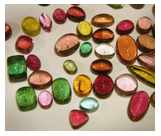
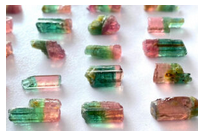
Varieties
Tourmaline’s composition is highly variable, leading to many different colored varieties. Fe-rich varieties are black; Mg-rich varieties are often brown or yellow; Li-rich varieties may be blue or green; Mn-rich varieties are pink or red. These varieties are named according to their colors:
xx•black-blue tourmalines are schorl
xx•brown-yellow tourmalines are dravite
xx•variable blue tourmalines are elbaite
xx•red or pink tourmalines are rubellite
Figure 14.150 shows some of the different colored tourmalines that have been shaped and polished to make cabochon gems. Figure 14.151 shows examples of multicolored watermelon tourmaline.
Related Minerals
Tourmaline is structurally related to beryl, Be3Al2Si6O18; cordierite, (Mg,Fe)2Al4Si5O18; dioptase, CuSiO2; and benitoite, BaTiSi3O9. All contain hexagonal rings of SiO4 tetrahedra.


